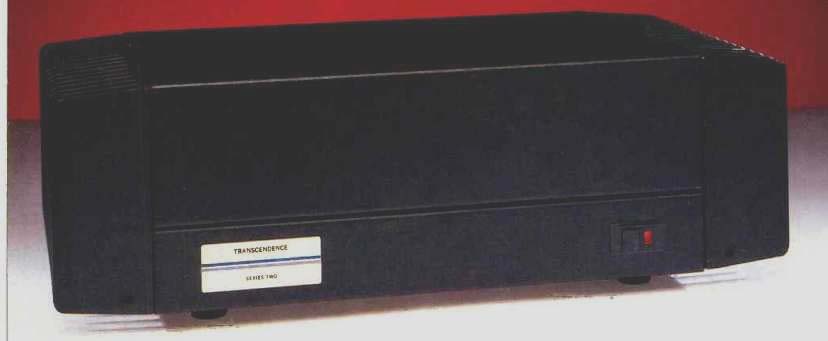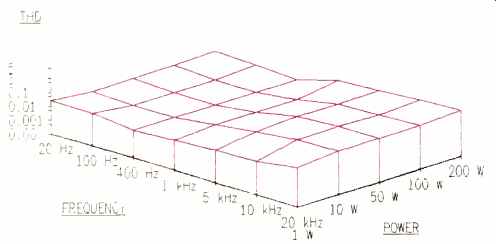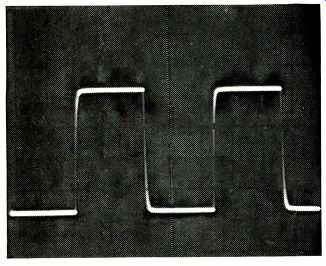
Manufacturer's Specifications
Power Output (20 Hz to 20 kHz): 140 watts per channel, continuous, both channels driven into 8-ohm loads; 200 watts per channel into 4-ohm loads.
THD: Less than 0.1% at rated output.
Frequency Response: 10 Hz to 210 kHz, +0,-3.0 dB.
S/N: 90 dB unweighted peak re: rated output.
Input Sensitivity: 1.4 V rms for rated output.
Input Impedance: 100 kilohms.
Output Impedance: 0.04 ohm.
Phase: Noninverting.
Rise-Time: 3µS at rated power.
Slew Factor: "Infinite."
Dimensions: 16 in. W x 5 1/4 in. H x 10 in. D (40.6 cm x 13.3 cm x 25.4 cm).
Weight: 26 lbs. (11.8 kg).
Price: $1,250; $900 if customer furnishes Hafler DH-220 or DH-200 power amplifier.
Company Address: Audio by Van Alstine, 2202 River Hills Dr., Burnsville, Minn. 55337, USA.
I've known about Frank Van Alstine for quite some time, and so I was eager to put one of his amplifiers through its paces. Mr. Van Alstine runs a stereo shop in Minnesota, but unlike most audio retailers, he does a lot more than just buy and sell equipment. For many years now, Van Alstine has been designing and producing high-quality preamplifiers, power amplifiers, and other audio components and accessories. He strips out the insides of amplifiers and preamps originally made by such respected firms as Hafler, Dyna, and Crown and uses their metal chassis and structural parts to house his own circuits. As Van Alstine puts it, "By taking advantage of mass-produced, low-cost metal parts, selected for excellent mechanical layout and durability, we can provide a more useful range of choices at realistic prices." Van Alstine's breezily written catalog lists more than a dozen preamplifiers, a dozen amplifiers, and a couple of integrated amps, as well as "Other Good Stuff" (as he puts it) such as cartridges and a CD player. He also offers non-rebuilt components from such makers as Harman/Kardon, B & W, and Hafler.
The catalog describes the amplifier I tested, the Transcendence 250 Series Two, as a "best-selling 280-watt delicate and detailed classic." This powerful amp uses the metalwork as well as the power transformer from a Hafler DH-220 or DH-200 power amplifier. As Van Alstine stresses in his brief (two sides of a single sheet) "Operation Instructions," all internal circuits are brand new, including five printed circuit cards of his own design (two audio boards, two full ground-plane shielded output boards, and a power-supply board containing 40,000 µF worth of filter capacitors). Audio by Van Alstine (A.V.A.) products can be purchased by mail order directly from the firm, but you might prefer to write for a catalog and order form. You can order a new unit or send in an old one (which need not be in working order) for rebuilding.

Fig. 1-THD vs. power and frequency, with amp driving 8-ohm load. THD scale
is logarithmic.

Fig. 2-Same as Fig. 1 but with 4-ohm load.
According to Van Alstine, there is a patent pending on the pre-driver circuit, and he requested that we not publish the schematic. Without readers being able to refer to a diagram, it would be rather pointless on my part to try to describe the circuit on a stage-by-stage basis. This much, however, can be said about the topology of the Transcendence 250: The amplifier has a 100-kilohm input impedance that is independent of feedback, so it does not vary with frequency. As a result, any preamplifier can drive it successfully without being "loaded down." The pre-driver section has no notice able dynamic phase shift; a compensation capacitor deter mines the phase and gain of the circuit independent of voltage and current through the pre-driver. Furthermore, the pre-driver circuit has a very low output impedance and can therefore drive the gate capacitance of the power MOS FETs used in the output stages without current limiting.
Van Alstine claims--and I was able to verify--that the amplifier is d.c. stable. It has no on or off pulses and exhibits no d.c. center-line drift even when the a.c. line voltage is varied over a wide range.
The amplifier has what might best be described as an infinite slew factor (not to be confused with "slew rate"). As decreed by the IHF (now EIA) Amplifier Measurement Standard, slew factor is determined by sweeping upward in frequency (after first having set input levels to produce full output at some mid-frequency) until distortion levels reach 1.0%. What usually happens is that when you get high enough in frequency (outside the audio band), the wave shape becomes triangular and exhibits higher and higher levels of measurable distortion. In the case of the A.V.A. amplifier, the output waveform, though decreasing in amplitude as higher and higher frequencies are reached, never deviates from its sine-wave 'shape. Since slew factor is calculated by dividing the high frequency needed to pro duce 1% THD by 20 kHz, and since that level of distortion cannot be reached before the signal is attenuated to minuscule levels, Van Alstine is justified in claiming "infinite" slew factor, or at least a slew factor that is unmeasurable with practical test equipment.
Externally, the resembles indeed it should, since the metal parts are the same. New Switchcraft input jacks have been substituted for those originally found on the Hafler unit, and color-coded "banana" output jacks are provided on the apron of the amplifier chassis. Fuse-holders next to the output jacks contain 4-ampere quick-acting fuses that will normally pass the full power of the amplifier under music-signal conditions. These are wired in series with the speaker terminals. Five more fuses are inside the amplifier: The main a.c. line has a 7-ampere slow-blow fuse, and two pairs of 4-ampere quick-acting fuses protect the power supply. These are wired in series with the output circuits.
Thermal overheat sensors are located on each heat-sink.
The sensors are connected in series with the a.c. power line, ahead of all circuits, and will open if either audio channel overheats. In the event of a thermal shutdown, a Transcendence 250 built into the DH-220 chassis (as the test sample was) will make its power-indicator lamp blink.
The amplifier will turn back on automatically once the over heated heat-sink cools down.
Mono operation can be accomplished by removing the power-supply fuses from the unused channel, thereby making the entire power supply available to the channel that remains, or by using an external bridging kit. According to Van Alstine, removing one channel's power fuses adds only about 1 dB or so of power to the other channel, but using the bridge will yield an output in excess of 300 watts, steady-state. I didn't test the amplifier for mono operation since I was not supplied with this bridge. (The latest version of the Transcendence Bridge is a $100 p.c. board that uses, a preamplifier's power supply and can be built into most models; Van Alstine will do the building-in. The Hafler mono bridging kit, normally used with the Hafler DH-220 amplifier, cannot be used with the Transcendence 250.)

Fig. 3--Reproduction of a 20-kHz square wave (see text).
Measurements
The amplifier easily delivered its rated power into 8-ohm loads over the entire audio range from 20 Hz to 20 kHz. In fact, at mid-frequencies, THD for 140 watts output per channel was only 0.01%, as against a rated THD of 0.1%. At 20 Hz, THD was no greater, but it did tend to rise a bit at the high-frequency end of the band, reaching 0.06% at 20 kHz.
Dynamic headroom, a truer measure than steady-state power of what the amplifier can do when fed typical music signals, was a high 2.0 dB. This means that with short-
duration input signals such as those likely to be encountered in real-world use, the amplifier can deliver power peaks of close to 190 watts per channel into 8-ohm loads. A "3-D" graph showing harmonic distortion as a function of both frequency and power output is plotted in Fig. 1.
SMPTE-IM distortion was also low, measuring only 0.013% at rated output.
The amplifier did not do quite as well during static bench tests when driving 4-ohm loads. Although mid-frequency THD remained very low at rated output (200 watts per channel), THD at higher frequencies tended to climb more rapidly as continuous power-output levels were increased.
At 20 kHz, THD reached 0.2%, though SMPTE IM remained low, with a reading of only 0.022%. Figure 2 is a plot similar to that of Fig. 1 except that the load impedance has been changed to 4 ohms. Because of the value of the fuses installed in the speaker lines (and the admonition by Van Alstine that installing higher rated fuses might damage the output devices), I was unable to check operation of the amplifier at high levels for even lower impedances. How ever, later experiments with several of the speaker systems that I have in my lab (at least one of which has given some high-powered amplifiers a hard time because of its low impedance at certain frequencies) suggest that the A.V.A. is not likely to be upset by unusual speaker loads.
Frequency response was flat within ± 1.0 dB from 20 Hz to 115 kHz, and the -3 dB point was reached at 175 kHz.
Input sensitivity, measured in accordance with IHF Standards, was 0.12 V for 1 watt of output. I have a sneaking suspicion that Van Alstine supplied me with an incorrect manufacturer's specification for signal-to-noise ratio. (All of the specs for this amplifier were detailed in a letter that he sent me after I had finished measuring the sample; neither the operating instruction sheet nor the Van Alstine catalog lists technical specifications for the product.) The S/N ratio he gave me was 90 dB unweighted peak noise below rated output. If, in fact, the amplifier had only done that well it wouldn't have been anything to rave about. In my tests, conducted as usual using the IHF (EIA) Measurement Methods, the amplifier exhibited a 90-dB signal-to-noise ratio referenced to 1 watt of output! If I were to translate that to a signal-to-noise figure relative to rated output, I'd have to add another 21.8 dB to the measurement-which would bring the S/N (relative to full rated output) up to a much more impressive 111.8 dB. That's more like it! The excellent rise-time and slew factor of this unit prompted me to take some 'scope photos of square waves as they appeared at the output terminals. I have generally given up this practice because the results are nearly always the same: Perfectly square for a 1-kHz square wave and severely rounded for any square wave having a frequency above 10 kHz or so. Well, consider the result shown in Fig. 3. What would you guess was the frequency of this test signal: 1 kHz? 5 kHz? 10 kHz? Wrong in each case. What you're looking at is the Transcendence 250's output when a 20-kHz square wave is applied to the input! How about that for fast rise-time and fast transient response?
Use and Listening Tests
The more I listened to this outstanding amplifier, the more I came to believe that Van Alstine is my kind of amplifier designer. Adjectives such as "smooth," "warm," and "clean" have been overused in trying to describe the sound delivered by amplifier/speaker combinations that are more or less faithful to the original music. I won't resort to them here. Instead, let me say that the music I heard was accurate and very pleasing. Regardless of loudness levels, I experienced absolutely no sense of fatigue, even after several hours of careful listening to musical fare that ranged from archival jazz recordings to recent all-digital CDs of some of my favorite classics. One recent Denon CD has two clarinet quintets: The well-known Mozart quintet in A and a Brahms quintet in B minor. The Mozart had sounded ever so slightly harsh even when I used my reference CD player.
Refusing to blame the player and not willing to admit that I had bought a less than outstanding CD, I inserted the Van Alstine Transcendence 250 in the signal chain. Amazingly, the slightly strident sound was gone. I imagine that even Mozart and Brahms would have been enthralled and pleased with the way their efforts were reproduced in my listening room. Perhaps this is what Van Alstine meant when he wrote in his catalog, "These amplifiers are opening eyes and changing minds among those who thought a solid-state amp could never sound as natural as a tube amplifier." Well, I never believed that in the first place, and I've heard other solid-state amplifiers which imparted that warm quality of sound attributed to tube amps, but I must confess that the few that did so cost considerably more than the A.V.A. Transcendence 250. Mr. Van Alstine certainly belongs in the class of producers whose amplifiers are a cut above the rest--and that's a very select group, indeed.
--Leonard Feldman
[AUDIO magazine/June 1987]
Also see: Audio Research SP-10 Preamp and D-70 Amp (June 1984)
[adapted from Audio magazine]